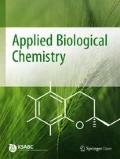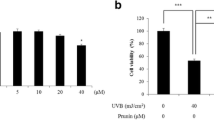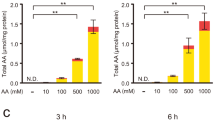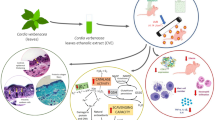Abstract
Ultraviolet B (UVB) irradiation induces skin damage and inflammation. Persimmon leaf extract (PLE) has traditionally been used for the treatment of acute and chronic diseases in Asia, but there have been no reports on its UVB-protective effects. Thus, protective effects of PLE against UVB-induced inflammations in HaCaT keratinocytes and mice were investigated. In an in vitro study using HaCaT keratinocytes, UVB irradiation decreased cell viability and increased chemokine production. PLE recovered cell viability and suppressed UVB-induced production of monocyte chemotactic protein-1 (CCL2) and cutaneous T cell-attracting chemokine (CCL27). Moreover, oral administration of PLE to UVB-irradiated mice resulted in significant suppression of skin damage. Histological analyses revealed that infiltration of inflammatory cells, especially degranulated mast cells, thickening of the epidermis, and hyperplasia were significantly reduced. PLE treatment suppressed UVB-induced CCL2 and CCL27 expressions in the skin. These results suggest PLE has potential as an effective material for protection against UVB-induced skin inflammation.
Similar content being viewed by others
References
Bei W, Peng W, Ma Y, and Xu A (2005) Flavonoids from the leaves of Diospyros kaki reduce hydrogen peroxideinduced injury of NG108-15 cells. Life Sci 76, 1975–1988.
Chen G, Wei SH HuangJ, and Sun J (2009) A novel Cglycosylflavone from the leaves of Diospyros kaki. J Asian Nat Prod Res 11, 503–507.
Di Girolamo N, Wakefield D, and Coroneo MT (2006) UVBmediated induction of cytokines and growth factors in pterygium epithelial cells involves cell surface receptors and intracellular signaling. Invest Ophthalmol Vis Sci 47, 2430–2437.
Fisher GJ, Wang ZQ, Datta SC, Varani J, Kang S, and Voorhees JJ (1997) Pathophysiology of premature skin aging induced by ultraviolet light. N Engl J Med 337, 1419–1428.
Fuchs J (1992) In Oxidative Injury in Dermatopathology. p. 91, Springer-Verlag, Berlin, Germany.
Guahk GH, Ha SK, Jung HS, Kang C, Kim CH, Kim YB, and Kim SY (2010) Zingiber officinale protects HaCaT cells and C57BL/6 mice from ultraviolet B-induced inflammation. J Med Food 13, 673–680.
Han J, Kang S, Choue R, Kim H, Leem K, Chung S, Kim C, and Chung J (2002) Free radical scavenging effect of Diospyros kaki, Laminaria japonica and Undaria pinnatifida. Fitoterapia 73, 710–712.
Issekutz AC and Movat HZ (1982) The effect of vasodilator prostaglandins on polymorphonuclear leukocyte infiltration and vascular injury. Am J Pathol 107, 300–309.
Ito T, Seo N, Yagita H, Tsujimura K, Takigawa M, and Tokura Y (2003) Alterations of immune functions in barrier disrupted skin by UVB irradiation. J Dermatol Sci 33, 151–159.
Jeong SI, Cho JK, Mok JY, Kim SJ, Park JM, Jeon IH, Kim HS, and Jang SI (2010) Antioxidant activity of persimmon leaves during growth. Kor J Pharmacogn 41, 255–263.
Kang JS, Kim HN, Jung da J, Kim JE, Mun GH, Kim YS, Cho D, Shin DH, Hwang YI, and Lee WJ (2007) Regulation of UVB-induced IL-8 and MCP-1 production in skin keratinocytes by increasing vitamin C uptake via the redistribution of SVCT-1 from the cytosol to the membrane. J Invest Dermatol 127, 698–706.
Kawakami K, Aketa S, Nakanami M, Iizuka S, and Hirayama M (2010) Major water-soluble polyphenols, proanthocyanidins, in leaves of persimmon (Diospyros kaki) and their alphaamylase inhibitory activity. Bio Biotech Biochem 74, 1380–1385.
Kotani M, Matsumoto M, Fujita A, Higa S, Wang W, Suemura M, Kishimoto T, and Tanaka T (2000) Persimmon leaf extract and astragalin inhibit development of dermatitis and IgE elevation in NC/Nga mice. J Allergy Clin Immunol 106, 159–166.
Mallavadhani UV, Panda AK, and Rao YR (1998) Pharmacology and chemotaxonomy of Diospyros. Phytochemistry 49, 901–951.
Matsumoto M, Kotani M, Fujita A, Higa S, Kishimoto T, Suemura M, and Tanaka T (2002) Oral administration of persimmon leaf extract ameliorates skin symptoms and transepidermal water loss in atopic dermatitis model mice, NC/Nga. Br J Dermatol 146, 221–227.
Meller S, Winterberg F, Gilliet M, Müller A, Lauceviciute I, Rieker J, Neumann NJ, Kubitza R, Gombert M, Bünemann E, Wiesner U, Franken-Kunkel P, Kanzler H, Dieu-Nosjean MC, Amara A, Ruzicka T, Lehmann P, Zlotnik A, and Homey B (2005) Ultraviolet radiation-induced injury, chemokines, and leukocyte recruitment: An amplification cycle triggering cutaneous lupus erythematosus. Arthritis Rheum 52, 1504–1516.
Nakamura K, Williams IR, and Kupper TS (1995) Keratinocyte-derived monocyte chemoattractant protein 1 (MCP-1): Analysis in a transgenic model demonstrates MCP-1 can recruit dendritic and Langerhans cells to skin. J Invest Dermatol 105, 635–643.
Pupe A, Moison R, De Haes P, van Henegouwen GB, Rhodes L, Degreef H, and Garmyn M (2002) Eicosapentaenoic acid, a n-3 polyunsaturated fatty acid differentially modulates TNF-α, IL-1α, IL-6 and PGE2 expression in UVB-irradiated human keratinocytes. J Invest Dermatol 118, 692–698.
Record IR and Dreosti IE (1998) Protection by black tea and green tea against UVB and UVA+B induced skin cancer in hairless mice. Mutat Res 422, 191–199.
Reddy GB and Bhat KS (1999) Protection against UVB inactivation (in vitro) of rat lens enzymes by natural antioxidants. Mol Cell Biochem 194, 41–45.
Rossi D and Zlotnik A (2000) The biology of chemokines and their receptors. Annu Rev Immunol 18, 217–242.
Sen CK and Packer L (1996) Antioxidant and redox regulation of gene transcription. FASEB J 10, 709–720.
Shibata A, Nakagawa K, Yamanoi H, Tsuduki T, Sookwong P, Higuchi O, Kimura F, and Miyazawa T (2009) Sulforaphane suppresses ultraviolet B-induced inflammation in HaCaT keratinocytes and HR-1 hairless mice. J Nutr Biochem 21, 702–709.
Shimauchi T, Sugita K, Nishio D, Isoda H, Abe S, Yamada Y, Hino R, Ogata M, Kabashima K, and Tokura Y (2008) Alterations of serum Th1 and Th2 chemokines by combination therapy of interferon-gamma and narrowband UVB in patients with mycosis fungoides. J Dermatol Sci 50, 217–225.
Shindo Y, Witt E, and Packer L (1993) Antioxidant defense mechanisms in murine epidermis and dermis and their responses to ultraviolet light. J Invest Dermatol 100, 260–265.
Simon MM, Aragane Y, Schwarz A, Luger TA, and Schwarz T (1994) UVB light induces nuclear factor-kB (NF-κB) activity independently from chromosomal DNA amage in cell-free cytosolic extracts. J Invest Dermatol 102, 422–427.
Soler D, Humphreys TL, Spinola SM, and Campbell JJ (2003) CCR4 versus CCR10 in human cutaneous Th lymphocyte trafficking. Blood 101, 1677–1682.
Steenvoorden DP and van Henegouwen GM (1997) The use of endogenous antioxidants to improve photoprotection. J Photochem Photobiol 41, 1–10.
Storey A, Rogers JS, McArdle F, Jackson MJ, and Rhodes LE (2007) Conjugated linoleic acids modulate UVR-induced IL-8 and PGE2 in human skin cells: Potential of CLA isomers in nutritional photoprotection. Carcinogenesis 28, 1329–1333.
Weichenthal M, Godorr M, Altenhoff J, Neuber K, and Breitbart EW (2000) Effects of whole-body UVB irradiation on cytokine production by peripheral blood mononuclear cells from stage I melanoma patients. Arch Dermatol Res 292, 348–353.
Xia X, Park E, Liu B, Willette-Brown J, Gong W, Wang J, Mitchell D, Fischer SM, and Hu Y (2010) Reduction of IKKalpha expression promotes chronic ultraviolet B exposure-induced skin inflammation and carcinogenesis. Am J Pathol 176, 2500–2508.
Yaar M and Gilchrest BA (2007) Photoageing: Mechanism, prevention and therapy. Br J Dermatol 157, 874–887.
Author information
Authors and Affiliations
Corresponding author
Rights and permissions
About this article
Cite this article
Cho, J.K., Park, J.M., Jeon, I.H. et al. Effect of persimmon leaf extract on utraviolet B-induced inflammation in HaCaT keratinocytes and mice. J Korean Soc Appl Biol Chem 54, 583–590 (2011). https://doi.org/10.3839/jksabc.2011.088
Received:
Accepted:
Published:
Issue Date:
DOI: https://doi.org/10.3839/jksabc.2011.088




